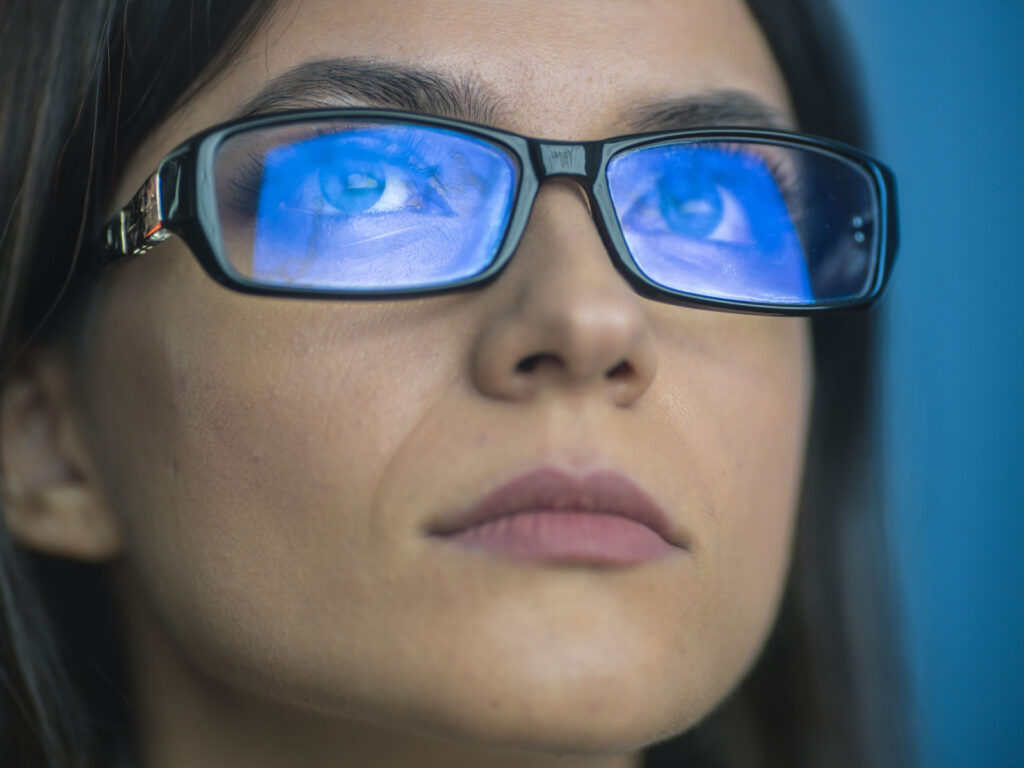Glasses Over Contact Lenses
Blue light glasses have been a popular specialty eyewear topic, especially as daily screen time rises. Yet, many people choose contact lenses to avoid slipping on spectacles. So, is adding a blue light filter worth it for contact lens wearers? And can you wear blue light glasses with contacts?
What Is Blue Light?
While many people have heard of blue light glasses, fewer people know the reasons for wearing them. The world is full of light, visible and invisible. Blue light is a type of visible light on the electromagnetic spectrum. It has the highest energy of all visible light, landing just before UV light on the spectrum.
UV light is well-known for some of its harmful properties, which is why we wear sunscreen, sunglasses, and other sun protection. Blue light is not as powerful as UV light, but it can have a harmful effect when we’re overexposed.
Fortunately, most sources of blue light are weak. The sun is the most significant source, but particles in the atmosphere scatter blue light, reducing its impact. Notably, artificial sources of blue light, such as laptops, phones, or lightbulbs, emit a lower intensity of blue light.
Our eyes can block some UV light but are less effective at blocking blue light. Additionally, our eyes have greater difficulty focusing high-energy light waves, like blue light. As a result, prolonged blue light exposure can contribute to digital eye strain.
Short-term exposure to low-intensity blue light sources is unlikely to harm your vision. Unfortunately, like sun exposure, blue light exposure is cumulative. Prolonged exposure over time can increase the risk of developing eye diseases, including cataracts and macular degeneration.
Blue light also affects sleep patterns, stimulating us to stay awake by blocking melatonin production. Staring at a digital screen in the morning might help you wake up, but scrolling through apps before bed can make it trickier to fall asleep.
Do Contacts Block Blue Light?
Many contact lens brands have designed contacts with unique features or filters. For example, some contacts offer UV protection or transition in response to lighting conditions. There are also options for blocking blue light.
Not all contact lenses include blue-light-blocking technology. If you’re interested in the feature, talk to your eye care provider about brands that can offer the features you want.
One thing to keep in mind about contact lenses with blue light or UV protection is size. Traditional contact lenses cover the cornea, the front part of the eye, but don’t cover the sclera (the white of the eye).
Placing a blue light filter over the cornea area can help protect essential tissue inside the eye. However, part of the eye is still exposed. There’s also a chance the lens may move or slip.
Sunglasses and eyeglasses cover more surface area, protecting more of the eye. Wraparound sunglasses can provide even greater protection, preventing light from reaching the eye from sides or angles.
Contact lenses that block blue light can be effective, particularly if you only wear contact lenses. Adding sunglasses or blue light glasses over your contact lenses may optimize protection for patients equally comfortable wearing spectacles.

Wearing Contacts with Blue Light Glasses
Contact lenses are often chosen as an alternative to eyeglasses. However, people with high prescriptions may need to simultaneously wear contact lenses and glasses to correct their vision. The separate prescriptions are designed to work together.
People who prefer contact lenses may choose to own prescription glasses as a backup. For example, you might wear your backup pair when your eyes need a rest, or you’ve discarded your contacts at the end of the day. Although the prescriptions differ, simultaneously wearing your regular contacts and backup glasses is not recommended.
Wearing both at the same time won’t harm your eyes. But it can feel uncomfortable if the prescriptions are incompatible. The same is true if you wear prescription blue light glasses over prescription contacts.
Fortunately, blue light glasses can be prescription or nonprescription.
Wearing non-prescription blue light glasses with contact lenses is similar to wearing sunglasses. The eyewear adds a protective shield but has a limited effect on your vision. For example, some people notice blocking blue light can change colour perception, similar to how tinted sunglasses or darker shades may alter colours.
In most cases, you can wear blue light glasses with contacts. However, if wearing both at the same time is uncomfortable, switch to one at a time. Or, talk to your optometrist about alternatives.
Looking for Quality Contacts?
At eyeDOCS Ottawa, we’re committed to serving our patients with quality care. So whether you love your contact lenses or can’t go anywhere without your fashionable frames, you deserve lens technology that meets your needs.
You have a lot of options, and that can lead to a lot of questions. When you’re curious about lens features like blue light filters, we’re here to help. We want to support your visual comfort. Request an appointment today!




